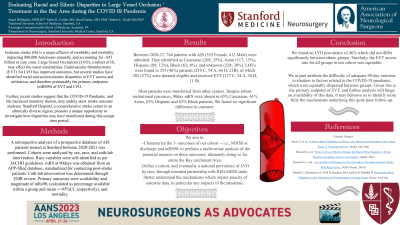Evaluating Racial and Ethnic Disparities in Large Vessel Occlusion Treatment in the Bay Area during the COVID-19 Pandemic
Evaluating Racial and Ethnic Disparities in Large Vessel Occlusion Treatment in the Bay Area During the COVID-19 Pandemic
Friday, April 21, 2023


Angel Billingsley, MPH, JD
Medical Student
Stanford Medicine
Mobile, Alabama, United States
ePoster Presenter(s)
Introduction: Acute Ischemic stroke (AIS) results in significant morbidity and mortality, impacting 850,000 Americans annually, and accounting for billions in costs. Large Vessel Occlusions (LVO) are particularly associated with poorer outcomes, and while Endovascular Thrombectomy (EVT) for LVO has enhanced care, studies have identified disparities in EVT access, utilization, and therefore presumably results. The COVID-19 pandemic increased the burden on care delivery systems, prolonging time to diagnosis, treatment and followup, and in some cases access to care. We evaluate whether disparities in LVO manifested during this unique era at a large comprehensive stroke center (CSC).
Methods: A retrospective analysis of a prospectively acquired database of AIS patients treated at a single CSC between 2020-2021 was performed. Cohorts were analyzed by sex, race, and endovascular intervention. Race and ethnicity was self-identified, modified Rankin Score (mRS) at 90 days was procured by standardized patient contact. Primary outcomes were mRS at 90 days, and mortality.
Results: Between 2020-21, 764 patients with AIS (352 Female, 412 Male) were admitted. They identified as Caucasian (268; 35%), Asian (117; 15%), Hispanic (89; 12%), Black (62; 8%), and unknown (228; 30%). LOVs were found in 355 (46%) patients (219 C, 54 A, 60 H, 21B), of which 202 (57%) were deemed eligible and received EVT (127 C, 34 A, 30 H, 11 B). Most patients were transferred from other centers. Despite robust institutional resources, 90 day mRS were absent in 65% Caucasian, 61% Asian, 63% Hispanic and 83% Black patients. We found no significant difference in outcome.
Conclusion : We found an LVO prevalence of 46% which did not differ significantly between ethnic groups. Similarly, the EVT access rate for all groups in our cohort was equitable. We attribute the difficulty of adequate 90 day outcome evaluation to factors related to the COVID-19 pandemic, which were equitably dispersed between groups.
Methods: A retrospective analysis of a prospectively acquired database of AIS patients treated at a single CSC between 2020-2021 was performed. Cohorts were analyzed by sex, race, and endovascular intervention. Race and ethnicity was self-identified, modified Rankin Score (mRS) at 90 days was procured by standardized patient contact. Primary outcomes were mRS at 90 days, and mortality.
Results: Between 2020-21, 764 patients with AIS (352 Female, 412 Male) were admitted. They identified as Caucasian (268; 35%), Asian (117; 15%), Hispanic (89; 12%), Black (62; 8%), and unknown (228; 30%). LOVs were found in 355 (46%) patients (219 C, 54 A, 60 H, 21B), of which 202 (57%) were deemed eligible and received EVT (127 C, 34 A, 30 H, 11 B). Most patients were transferred from other centers. Despite robust institutional resources, 90 day mRS were absent in 65% Caucasian, 61% Asian, 63% Hispanic and 83% Black patients. We found no significant difference in outcome.
Conclusion : We found an LVO prevalence of 46% which did not differ significantly between ethnic groups. Similarly, the EVT access rate for all groups in our cohort was equitable. We attribute the difficulty of adequate 90 day outcome evaluation to factors related to the COVID-19 pandemic, which were equitably dispersed between groups.
